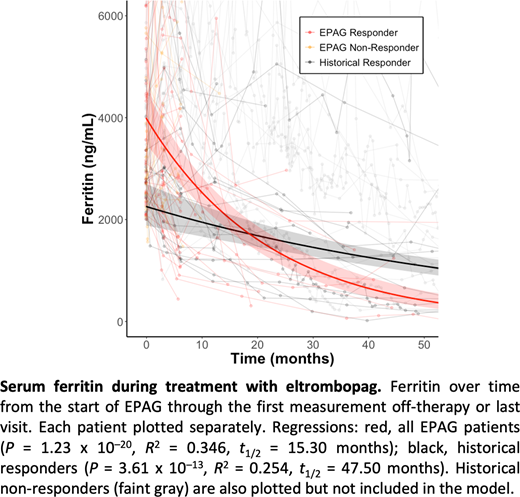Eltrombopag (EPAG) is a non-peptide, thrombopoietin receptor agonist approved for several forms of thrombocytopenia, as well as severe aplastic anemia in first line (combined with immunosuppressive therapy) and refractory (single agent) settings. It is effective in moderate aplastic anemia and under investigation for myelodysplastic syndrome (MDS) and other marrow failure conditions. Although aplastic anemia (AA) patients often respond to EPAG and become drug-independent, this may take months to years, and some patients remain either continuously or intermittently EPAG-dependent. Previously, we and others have reported that EPAG chelates and mobilizes iron in a cohort of AA patients. We present a larger cohort of AA/MDS patients from 4 prospective clinical trials of EPAG, and report declining iron stores on extended EPAG therapy, including some patients developing frank iron deficiency anemia (IDA) responsive to oral or parenteral supplementation, and others normalizing prior severe iron overload during extended EPAG therapy. We report the kinetics of this effect and analyze its impact, if any, upon response and relapse.
317 patients were treated with EPAG for unilineage cytopenia, AA or MDS. 206 AA patients treated on non-EPAG protocols served as historical controls. Average follow-up was 42.9 months (2.2-206.7) for EPAG and 69.6 months (6.1-196) for controls. Average time on EPAG was 9.0 months (0.4-81.1); 73 patients (23.0%) were treated for ≥ 7 months. Average baseline serum ferritin (SF) was 1757 ng/mL (29-18977) for EPAG; 1628 ng/mL (14-8438) for controls (N.S.), with iron overload (SF ≥ 1000 ng/mL) in 56.5% of EPAG patients; 53.9% of controls (N.S.).
On EPAG, serum iron (2x over baseline, P < 1.3 x 10-39) and transferrin saturation (85.1% of patients have 100% saturation) are elevated due to binding by EPAG, while serum ferritin (SF) does not correlate with iron or transferrin saturation. These effects resolve following EPAG therapy: iron is 15% lower than baseline (P = 5.1 x 10-5), median saturation is 40%, and SF and iron correlate. No such dissociation is noted for historical controls. This implies that SF is the most reliable measure of iron status while on EPAG due to its chelating properties.
EPAG duration correlates with SF fold-reduction (R2 = 0.19, P < 4 x 10-14). SF levels during EPAG treatment follow first order (exponential) kinetics (R2 = 0.35, P < 2 x 10-20), with a clearance half-life of 15.3 months, independent of baseline SF. There is minimal correlation of treatment response with SF kinetics (P = 0.04). In comparison, historical responders demonstrate a significantly slower SF clearance (P < 8 x 10-10) with a half-life of 47.5 months. SF half-life on EPAG is comparable to that of chelators such as deferoxamine or deferasirox used for transfusion-related iron overload in AA/MDS. This similarity in kinetics and the fact that this effect is independent of treatment response (and thus transfusion burden) support a role for EPAG in actively depleting total body iron.
Of 305 evaluable patients, 62 (9.8%) had iron-depletion as measured by ferritin. 30 (7.5%) were during EPAG treatment with a median time of 55.0 months. 11 (3.6%) of patients experienced falling hemoglobin or other signs of anemia. 9 started iron supplementation or discontinued EPAG, with improvement in the 5 patients who have had follow-up. Patients with EPAG-induced IDA follow the same kinetics (15.5-month half-life) as the general cohort.
Logistic models do not predict response based upon either baseline ferritin or kinetics. Furthermore, neither logistic nor Kaplan-Meier models identify any timepoint ferritin, baseline iron overload, or kinetics as predictors of relapse risk. While iron and ferritin may be biomarkers of disease and transfusion burden, they do not appear to drive outcomes, and do not support the recent hypothesis that response of marrow failure to EPAG is based on iron chelation and reversal the toxic impact of intracellular iron on hematopoietic stem cells.
Our data suggest a potential role for EPAG or its derivatives as iron chelators. More importantly, they demonstrate that EPAG can deplete iron stores, paradoxically requiring supplementation in previously overloaded patients. In addition to relapse, IDA should also be considered in responders on long term EPAG with declining hemoglobin. We recommend maintaining SF greater than 100 ng/mL so that these patients may continue this life-saving therapy.
Young:Novartis: Research Funding. Dunbar:Novartis: Research Funding.
Author notes
Asterisk with author names denotes non-ASH members.


This feature is available to Subscribers Only
Sign In or Create an Account Close Modal